In China, investment as a major component of demand and manufacturing as the major industry have long been drivers of economic growth. However, as the Chinese economy enters the "new normal" stage with economic growth moderating to medium-to-high speed, consumption and the service industry are replacing investment and manufacturing as the new growth engines.
Growth engine on the demand side shifting from investment to consumption
On the demand side, the growth engine of the Chinese economy is shifting from investment to consumption.
One of the characteristics of the Chinese economy is that the investment ratio (the ratio of capital formation to gross domestic product (GDP)) is much higher than the ratio of private consumption to GDP (Figure 1). In 2010 when the gap between these two was the largest, the former reached 47.2% while the latter remained at 35.9%. Since a fall in investment efficiency is inevitable if the investment ratio is raised further, China should rely on higher consumption to boost domestic demand.
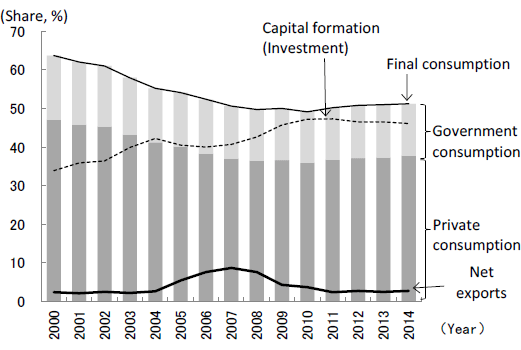
At the State Council executive meeting held on October 29, 2014, the Chinese government decided on a policy of expanding and upgrading consumption. The policy recognizes that consumption is an important engine for economic growth and holds great potential for China's development. Among the driving forces for stable growth, consumption demand is the largest in scale and has the closest bearing on people's livelihood. China should make full use of market forces to increase supply to match demand and promote the expansion and upgrading of domestic consumption. These efforts in turn will drive the growth of new industries and new businesses. The country needs to build an upgraded version of the Chinese economy by providing support so that it can shift to medium- to high-level growth.
First, personal income should be raised. Efforts should be made to increase farmers' income through various means and ensure that the income of the country's citizens grow in step with the economy. The payment ratio of the state-owned profits into the national treasury should be raised to provide more funds to support the people's livelihood.
The social security system should be improved. The level of medical insurance should be raised and critical illness insurance across the board should be promoted. A master plan should be formulated to facilitate the construction of a social welfare system.
In addition, the environment for consumption should be improved. Legislation to ensure the safety of consumption should be promoted, and acts such as the sale of low quality foods and the demand of outrageous fees in the tourism industry must be punished.
At the State Council executive meeting, the following six initiatives were listed as priority areas for promoting consumption.
- ① Support the development of online shopping and the improvement of distribution networks in the rural areas supporting them by expanding information consumption through the mobile Internet and the Internet of things, as well as increasing the speed of broadband. Accelerate the application of big data to healthcare and enterprise management, etc.
- ② Promote eco-friendly consumption by encouraging the wider use of energy-saving products and the construction of charging facilities for new energy cars.
- ③ Stabilize demand for housing, enhance the construction of housing for middle- and low-income individuals, and ease the conditions for the payment of rent from the Public Housing Reserve Fund.
- ④ Upgrade tourism and leisure consumption, thoroughly implement the paid holiday system, develop the tourism industry, and construct auto camping sites in poor regions in rural areas.
- ⑤ Enhance school management in cooperation with the central government.
- ⑥ Establish a tax system to support the investment of private capital in endowment services, and set water and electricity charges for private medical institutions equal to those for public institutions. Use better products and services that can be consumed without concern and help people to enhance the level of enjoyment in everyday life.
Higher wages associated with labor shortages and the narrowing income gap, along with government support, are also contributing to the expansion of consumption. As a result, the share of GDP in 2014 made up by private consumption rose to 37.7%, 1.8 percentage points higher than the lowest level in 2010.
Even though the economy has been decelerating since the beginning of 2015, the retail sales of social consumer goods (in nominal terms) from January through August maintained a relatively high rate of growth, increasing by 10.5% from the level of the previous year. In particular, online shopping rose 36.5% year on year. In addition, as indicated by the fact that the growth rate of retail sales in rural areas has been higher than that in urban areas since 2012, consumption is firming in rural areas, backed by rising income and the growth of online shopping.
The core of industry shifting from manufacturing to services
Consumption demand is shifting from goods to services. As many countries have experienced, the core of industry shifts from the primary industry (mainly agriculture) to the secondary industry (mainly manufacturing), and then to the tertiary industry (mainly services) as the economy develops. In the case of China, the share of the tertiary industry in GDP exceeded that of the secondary industry for the first time in 2013, and reached 52.5% in the first half of 2015. However, this level is still low compared to not only developed countries but also emerging countries at a similar stage of development as China, suggesting that there remains much room for China's tertiary industry to develop in the future (Figure 2).
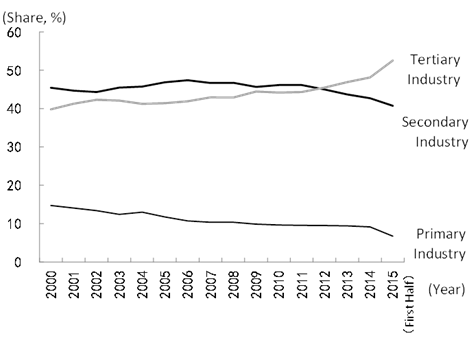
Premier Li Keqiang showed his recognition of the importance of the development of the service sector within his keynote address "Making the Service Sector the New Engine for Sustainable Economic and Social Development," which he delivered at the 2nd China Beijing International Fair for Trade in Services (CIFTIS) and the Global Service Forum Beijing Summit on May 29, 2013:
"Overall there is a sufficient supply of industrial goods in China, with some industries showing a serious surplus in production capacity, while in many areas of the service sector, supply does not meet demand. Raising the level of the service sector by increasing supply in a manner that is consistent with demand in the service sector will not only boost potential domestic demand and strongly support stable economic growth, but also make a significant contribution to the improvement of the economic structure. Focusing on the service sector will be beneficial for not only employment, but also environmental protection and sustainable economic development."
Premier Li points out the necessity of promoting the deep integration between industrialization and informatization and a synergistic effect by which a new type of urbanization and agricultural modernization mutually promote each other by developing the service sector to facilitate economic and social development, particularly the harmonic development of the "four new forms of modernization" (industrialization, informatization, urbanization, and agricultural modernization).
When promoting the development of the service sector, production-related services will be a priority area. Accelerating the development of the production-related service sector will be an important measure for promoting structural adjustments and stable economic growth, and will help to effectively unlock the potential of domestic demand, boost employment, and sustainably improve people's lives. It will also bring about the organic synthesis of the service sector with agriculture and manufacturing at a high level by raising the supply chains of the industry to a high end, as well as promote the improvement of the quality and efficiency and the upgrading of the economy.
Based on this recognition, the government decided at the State Council executive meeting held on May 14, 2014 that China should aim to improve the overall quality and competitiveness of the national economy by developing production-related services--such as research and development, design, business services, marketing, and after-sale services--in a focused manner by relying more heavily on the market mechanisms and innovation as the driving forces. The development of the production-related service sector is also expected to enhance the international competitiveness of Chinese products through higher productivity and the strengthening of supply chains.
Consumption- and service sector-related indicators are becoming increasingly important in judging business conditions
Reflecting these structural changes, consumption grew by 8.2% in the first half of 2015, with its contribution to GDP growth at 4.2%, higher than the growth rate and the contribution of investment, which were 5.4% and 2.5%, respectively (Figure 3). The growth rate of the tertiary industry was 8.4%, while its contribution to GDP growth was 4.2%. These results were higher than the secondary industry's growth rate of 6.1% and its contribution of 2.7% (Figure 4).
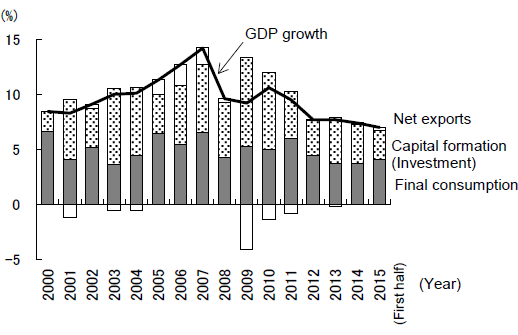
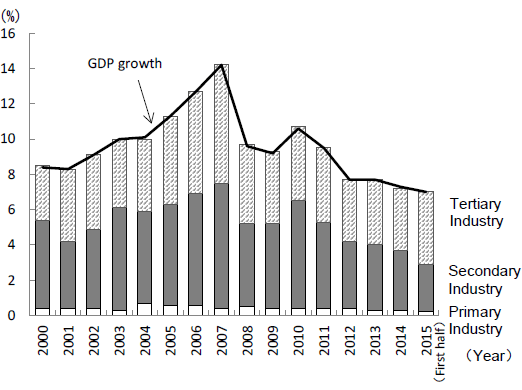
Recently, people have pointed out that the actual economic growth rate may be significantly lower than the 7.0% (for the first half of 2015) announced by the Chinese government because major economic indicators, such as industrial production and fixed asset investment, have been growing at a sluggish pace. However, given that the growth engine is shifting from investment to consumption on the demand side and from manufacturing to services in the industrial structure, official statistics should not be that far off from the actual figures. Rather, one could argue that it has become biased to judge business conditions primarily based on manufacturing and investment indicators.
For example, most people focus their attention on the manufacturing purchasing managers' index (PMI), but few talk about the non-manufacturing PMI centering on the service sector. It is true that the manufacturing PMI fell below the 50 level that separates expansion and contraction for two consecutive in August (49.7) and September (49.8). However, the non-manufacturing PMI as well as the simple average of the manufacturing PMI and the non-manufacturing PMI ("composite PMI") continued to exceed 50 (Figure 5). This suggests that current business conditions are not that bad.
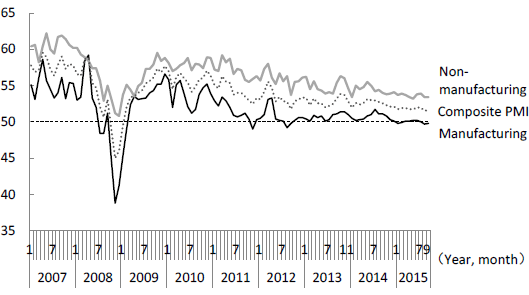
Taking into account these structural changes in the Chinese economy, greater emphasis should be placed on consumer- and service-related indicators when judging business conditions in the future.
The original text in Japanese was posted on October 21, 2015.


